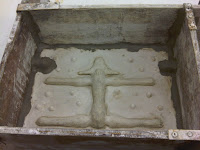To start with, I had to come up with a way to suspend the armature in the mould so the foam latex could get around the whole thing properly and also didn't touch the sides.
To do this I carefully cut slits into one half of the mould, one on each leg. From this I placed a small piece of 1mm aluminium wire, that the armature would now rest on quite securely, and when both halves of the mould are pressed together the armature won't move a mm.
With the armature ready to go, me and Alex started mixing up a batch of foam latex.
We followed the instructions, to the letter, making a medium/soft density foam mix, which we used for both the fox and badger we did.
After about 15 or so minutes of constant mixing and adding the difference ingredients the foam latex was ready to be put into the mould.
We simple scooped out the foam latex with our hands and filled the mould as full as possible, trying to remove all air bubbles and get the foam latex into every nook and cranny.
I used a small syringe to squirt the foam latex into my fox's ears and nose to avoid any possible air bubbles in these extremities.
With both sides filled and the armature placed carefully into position, both halves of the mould were pushed together and then pressure was applied to them for about 15 minutes (me standing on it) before putting into the kiln at 90oC for about 6 hours.




























































